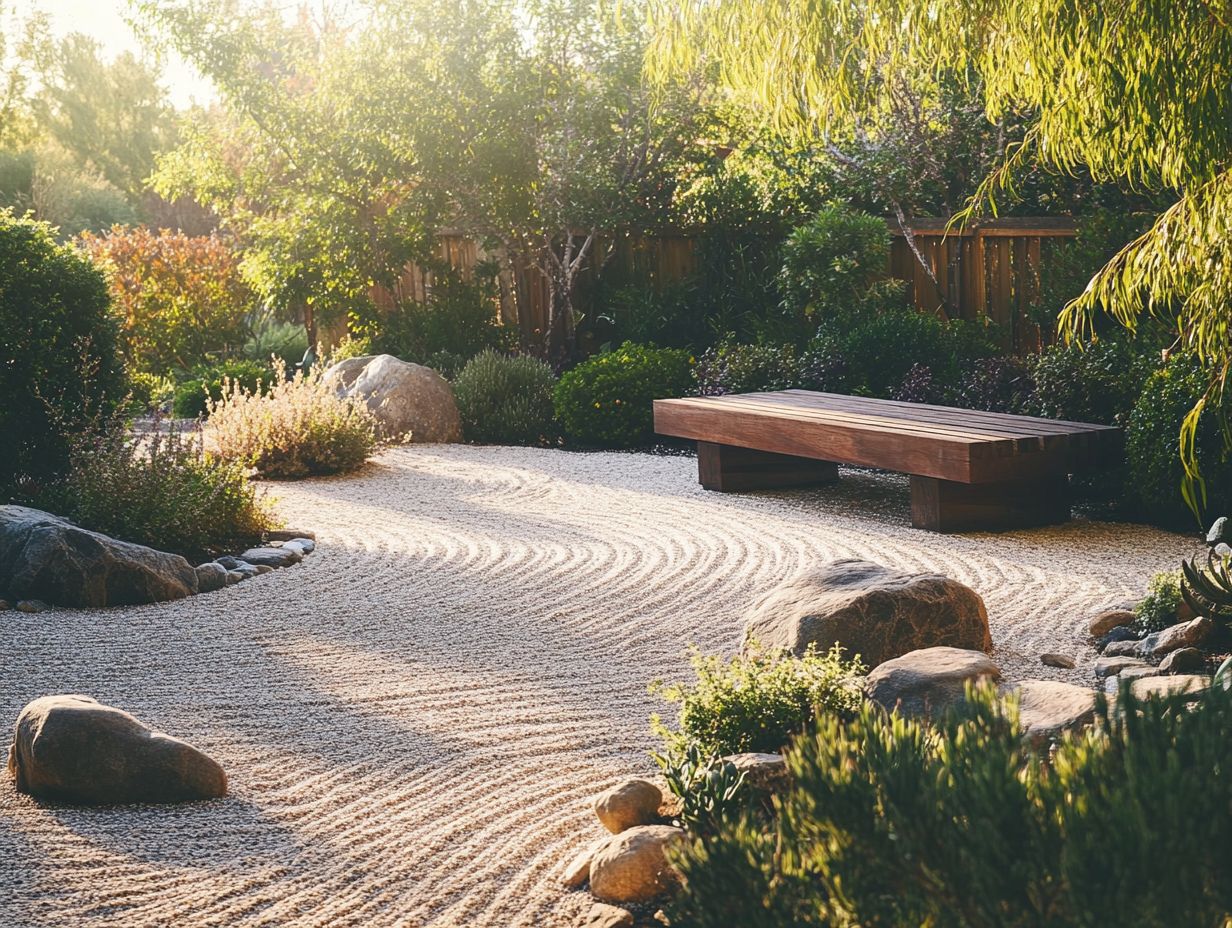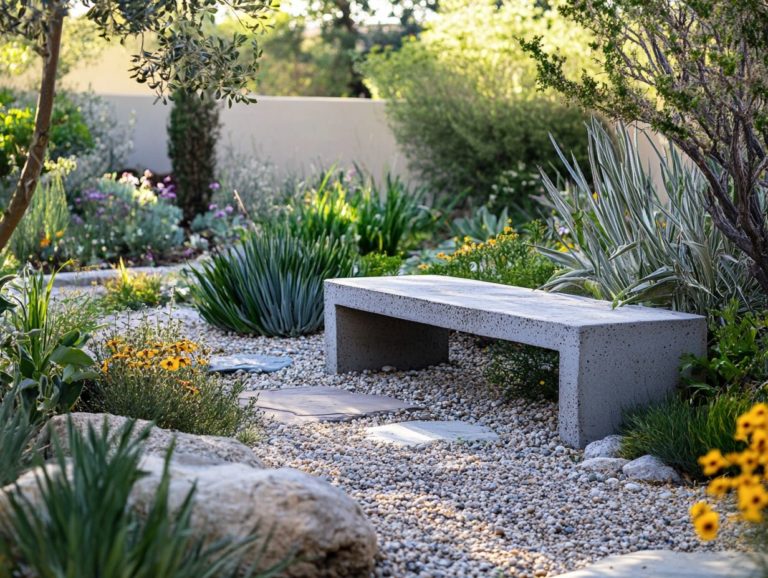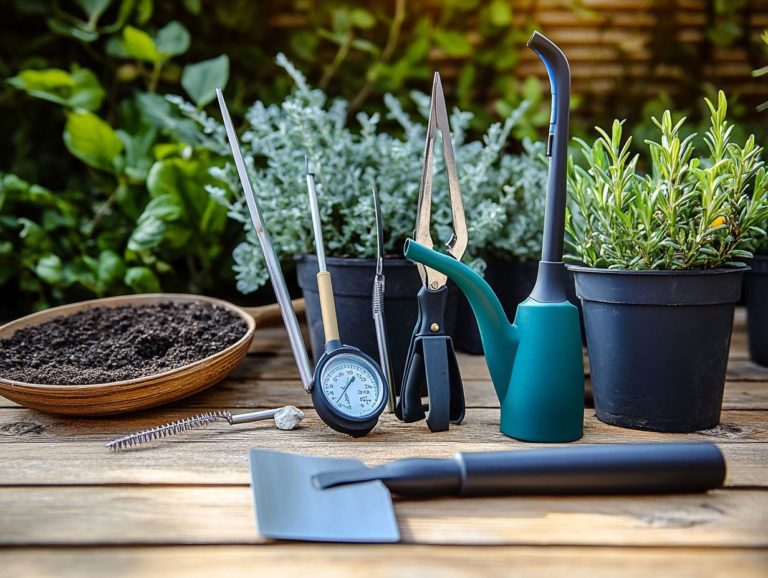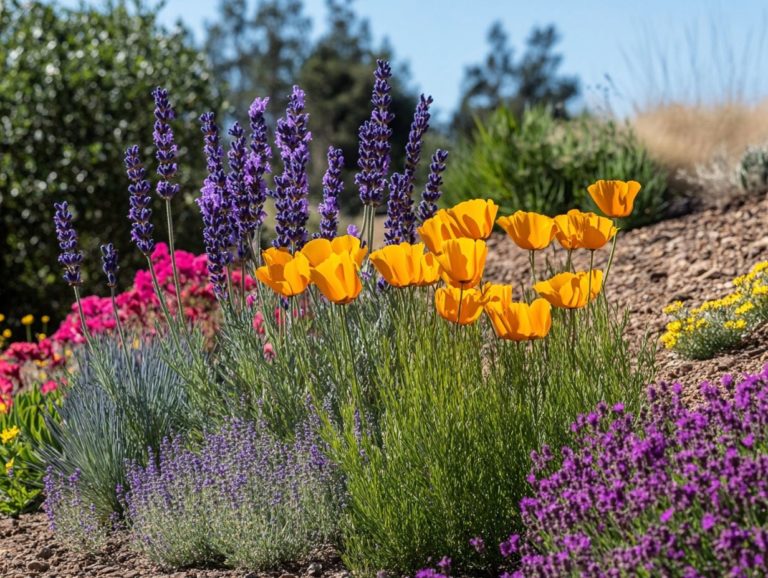Creating a Zen Garden in Drought Areas
Drought-prone regions face unique challenges that require innovative solutions. A Zen garden not only provides a peaceful retreat but also offers mental health benefits in these dry landscapes.
This article explores the characteristics of drought areas and the advantages of Zen gardens. You ll learn how to design one using drought-resistant plants and water-saving techniques.
We also provide maintenance tips and alternative landscaping ideas. You can cultivate tranquility even in dry conditions!
Contents
- Key Takeaways:
- Understanding Drought Areas
- Benefits of a Zen Garden in Drought Areas
- Designing a Zen Garden for Drought Areas
- Maintaining a Zen Garden in Drought Areas
- Alternative Options for a Zen Garden in Drought Areas
- Frequently Asked Questions
- What is a Zen Garden and why is it suitable for drought areas?
- What are the key elements to consider when creating a Zen Garden in a drought area?
- Do Zen Gardens in drought areas still require maintenance?
- What are some drought-resistant plants that are suitable for a Zen Garden?
- How can I add a touch of color to my Zen Garden in a drought area?
- Can I still have a peaceful and tranquil Zen Garden in a drought area?
Key Takeaways:

Understanding Drought Areas
Understanding drought areas is crucial, especially as climate change worsens environmental challenges. In these regions, water scarcity impacts local plants, animals, economies, and people’s mental health.
If you live in a drought area, seek innovative solutions. One effective approach is to incorporate Zen gardens, along with learning how to create a drought-resistant garden, which conserve resources while promoting tranquility.
Key Characteristics and Challenges
Drought areas experience long periods of water scarcity. This leads to vegetation loss and soil erosion.
This disruption impacts local ecosystems and can worsen community health issues as people compete for clean water. Agriculture also suffers, resulting in reduced crop yields and poor livestock health.
Farmers often turn to unsustainable practices, further degrading the land. Local communities experience increased competition for dwindling resources, leading to social tensions.
To combat these challenges, explore innovative water management and sustainable agricultural techniques. Collaboration within the community is essential for building resilience against drought impacts.
Benefits of a Zen Garden in Drought Areas
A Zen garden offers more than aesthetics; it enhances mental health and promotes tranquility in tough environmental conditions. It serves as a meditation space.
These minimalist landscapes encourage quiet contemplation and self-discovery. The arrangement of natural elements like gravel, rocks, and drought-resistant plants reflects the essence of a style of Japanese rock garden.
The principle of stillness in Zen gardens aligns with the need for sustainable practices. They provide a calming oasis while honoring nature’s constraints.
Environmental and Mental Health Benefits

Zen gardens provide you with profound environmental and mental health benefits. They create a tranquil space that nurtures your well-being and promotes sustainability, allowing for self-knowledge through quiet reflection.
These serene landscapes, often marked by raked gravel, thoughtfully placed stones, and carefully chosen drought-resistant plants, serve as your personal haven for meditation and self-reflection. By immersing yourself in these spaces, you can cultivate mindfulness, leading to reduced stress and heightened clarity.
The environmental practices included in the design of Zen gardens like the use of organic gardening methods and native flora not only enhance their visual allure but also positively impact local ecosystems. This harmonious fusion of mental restoration and environmental stewardship illustrates how Zen gardens can significantly enrich both your personal well-being and the health of the planet.
Designing a Zen Garden for Drought Areas
Designing a Zen garden for drought-prone areas demands a strategic mindset. It emphasizes the use of drought-resistant plants and incorporates creative landscape ideas for drought areas that harmonize with the natural landscape while fostering a sense of peace.
This endeavor requires you to carefully select materials and arrange elements such as gravel patterns, rocks, and organic mulch. The goal is to craft an aesthetically pleasing and tranquil environment that gracefully endures arid conditions.
Choosing Drought-Resistant Plants and Materials
Choosing drought-resistant plants and materials is vital for designing a Zen garden that flourishes in arid conditions. Consider integrating hardscaping in drought areas to enhance aesthetic beauty while supporting local wildlife.
Incorporating native species like lavender and succulents can greatly enhance your garden’s resilience. These plants are naturally adapted to thrive with minimal water. Grasses such as blue fescue or ornamental agave contribute to the serene ambiance and demand little maintenance, making them ideal companions in your design.
To achieve a cohesive look, consider grouping plants by their textures and colors. This approach creates visual interest and ensures that water usage is kept to a minimum. Complement your selections with gravel pathways or stone features, which will reduce water requirements while lending an elegant touch.
Transform your garden into a stunning retreat that connects you to nature, beautifully harmonizing with the drought-prone environment.
Incorporating Water-Saving Techniques
Incorporating water-saving techniques into your Zen garden design is essential. This is particularly important for maintaining ecological balance in drought-prone areas and creating a drought-resistant oasis to avoid the pitfalls of water scarcity.
By integrating rainwater harvesting systems, you can collect and store precious rainfall. This ensures a sustainable water supply for your serene sanctuary. Applying mulch retains soil moisture and enhances visual appeal, seamlessly blending with the tranquil gravel patterns that define Zen gardens.
Utilizing efficient irrigation systems, such as drip irrigation a watering method that delivers water directly to plant roots allows you to optimize water usage while keeping your landscape immaculate. These water-conscious methods enable peaceful coexistence with nature, giving you the power to create a harmonious environment that embodies both beauty and sustainability.
Maintaining a Zen Garden in Drought Areas

Maintaining a Zen garden in drought-prone areas demands meticulous planning and sophisticated watering techniques. For those looking to enhance their garden’s resilience, learning how to create a sustainable drought garden is essential to strike a balance that preserves both the garden’s tranquility and its aesthetic allure.
This ensures sustainability without sacrificing the serene beauty that defines this sacred space. Start your journey today! Create a peaceful oasis that flourishes in harmony with nature.
Effective Watering and Maintenance Practices
Effective watering and maintenance practices are essential for the vitality of your Zen garden, especially in drought-prone areas where creating a drought-tolerant garden can conserve water and maintain natural elements.
By embracing techniques like deep watering, you encourage your plants’ roots to strengthen and delve deeper into the soil, allowing you to reduce the frequency of your watering sessions. The timing of your efforts is equally important. Watering in the early mornings or late afternoons minimizes evaporation and provides plants with the moisture they need most.
Mulching around your plants helps retain soil moisture while keeping weeds at bay and enhancing the garden’s visual appeal. Incorporating organic practices like composting and using organic fertilizers boosts plant health and strengthens the ecosystem that supports your serene space.
Alternative Options for a Zen Garden in Drought Areas
Explore alternative options for a Zen garden in drought-prone areas to discover small space landscaping for drought areas that enhance aesthetics and promote sustainability and ecological balance.
Consider techniques like xeriscaping, which is landscaping that reduces the need for watering, and other drought-friendly practices. These methods harness the beauty of native plants such as moss and plum trees while optimizing water usage.
This approach allows you to create serene spaces that embody the essence of Zen design, achieving a harmonious balance between nature and mindful living reflective of the teachings of Japanese monks.
Xeriscaping and Other Drought-Friendly Landscaping Ideas
Xeriscaping stands out as a premier approach for crafting drought-friendly landscaping ideas in Zen gardens. It emphasizes water efficiency and the use of native plants such as peach trees and pine trees.
This innovative landscaping method conserves water and encourages the integration of drought-resistant plants such as succulents, agaves, and lavender. These selections thrive in arid conditions and elevate the garden’s aesthetic appeal.
Incorporating design elements like rock beds, gravel paths, and strategically positioned boulders enhances the tranquil ambiance that defines these spaces. With careful consideration of plants and materials, you can create a harmonious environment that celebrates the beauty of nature while skillfully navigating the challenges presented by climate conditions.
Frequently Asked Questions

What is a Zen Garden and why is it suitable for drought areas?
A Zen Garden, also known as a Japanese Rock Garden, is a traditional garden characterized by its minimalist design and use of rock, sand, and gravel instead of water. It is suitable for drought areas because it does not require regular watering and provides a space for quiet contemplation, which can enhance mental health.
What are the key elements to consider when creating a Zen Garden in a drought area?
The key elements to consider include:
- The type of rocks and gravel to use
- The placement and arrangement of these elements
- The selection of drought-resistant plants
Do Zen Gardens in drought areas still require maintenance?
Yes, Zen Gardens require maintenance even in drought areas. This includes raking the sand or gravel regularly, removing any weeds or debris, and pruning the plants as needed.
What are some drought-resistant plants that are suitable for a Zen Garden?
Drought-resistant plants that thrive in a Zen Garden include succulents, cacti, ornamental grasses, and Mediterranean herbs like lavender and rosemary. You can also consider adding Ginkgo biloba, Arctostaphylos manzanita, and Cercis occidentalis to attract pollinators and enhance the garden’s natural beauty.
How can I add a touch of color to my Zen Garden in a drought area?
Transform your Zen Garden instantly by incorporating colorful pebbles, vibrant succulents, or a small water feature that recycles water. You can also place cherry trees, plum trees, or azaleas for visual interest throughout the seasons.
Can I still have a peaceful and tranquil Zen Garden in a drought area?
Absolutely! The goal of a Zen Garden is to create a peaceful space, even in drought conditions. To enhance this tranquility, consider incorporating wildlife-friendly drought gardening techniques, focusing on thoughtful design, proper placement of elements, and maintaining the garden with natural gardening methods like raking gravel.






